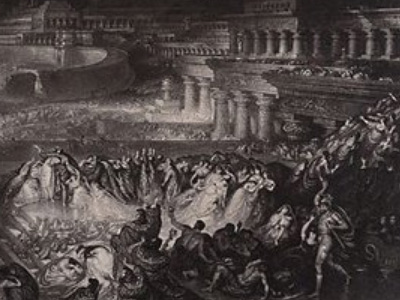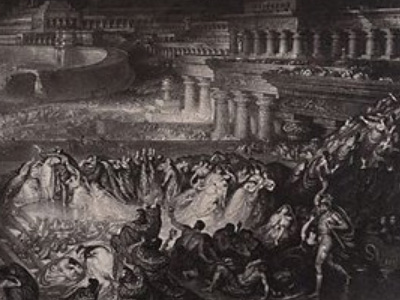Battle of Nineveh (612 BC)

The Battle of Nineveh is conventionally dated between 613 and 611 BC, with 612 BC being the most supported date. An allied army composed of Medes and the Chaldeans, rebelling against the Assyrians, together with Scythians and Cimmerians, besieged it and sacked 750 hectares of what was at that time, the greatest city in the world. This led to the destruction of the Neo-Assyrian Empire over the next three years as the dominant state in the Ancient Near East. After this battle, the archeological record shows that the capital of the once mighty Assyrian Empire was extensively de-urbanized and depopulated.
Babylon became the imperial center of Mesopotamia for the first time in over a thousand years, leading to the Neo-Babylonian Empire, claiming imperial continuity as a new dynasty.
Background
The Neo-Assyrian Empire arose in the 10th century BC and reached its peak in the 8th and 7th centuries BC, succeeding the Middle Assyrian Empire (1366-1074 BC) as the largest empire the world had yet seen. By the reign of Ashurbanipal, it controlled or held in vassalage most of the nations and city-states from the Caucasus Mountains (modern Armenia, Georgia and Azerbaijan) in the north to Egypt, Arabia and Nubia in the south, and central Iran/Persia in the east to Cyprus and the Hellenic and Phoenician Mediterranean coasts of Anatolia and the Levant in the west.
However, after the death of Ashurbanipal in 627 BC, the once mighty empire of Assyria was becoming increasingly volatile, with Assyria proper erupting into a series of internal civil wars. This led many of the subject states, many of which had their own political dynasties, to become restive, whereas neighbouring states and groups, such as the Medes, Persians, Babylonians, Chaldeans, Scythians, Cimmerians became increasingly hostile under the Assyrian hegemony.
The Assyrians had, by the accounts of their own records, been brutal even by the standards of the time, and thus had accumulated many hitherto impotent enemies. It had been weakened by a three front struggle to maintain power in Egypt, a costly but victorious war against the Elamites, and put down rebellions amongst their southern Mesopotamian Babylonian kinsmen, even though the core of the empire had been largely at peace. The Assyrian monarchs wrote constantly of internal danger, fear of palace intrigue, and feared a rebellion.
Upon the death of Ashurbanipal, a series of bitter and bloody wars of succession occurred, weakening the empire – from 625 BC onwards, the Neo-Assyrian Empire's domination over the Middle East, Asia Minor, Caucasus and East Mediterranean gradually began to fade.
An alliance grew up of external states, such as the Chaldeans, who took advantage of the upheavals in Assyria to take control of much of Babylonia with the aid of the Babylonians themselves. They were building Babylonia into a power that is termed Neo-Babylonian. The goal was the overthrow of the Assyrian dynasty, the taking of the capital, Nineveh and the transferral of the seat of Mesopotamian power to Babylon. Nineveh was not only a political capital, but home to one of the great libraries of Akkadian tablets and a recipient of tribute from across the near east.
Account of the Battle
According to the Babylonian Chronicles, there was a bitter 12-year struggle between Babylon and Assyria, as well as civil wars in Assyria itself. They describe that in the tenth year of Nabopolassar (616 BC) the Babylonians defeated the Assyrian army and marched up the river sacking Mane, Sahiri and Bali-hu.
The conflict renewed the next year, with the Assyrians mustering their army and throwing the Babylonians back to Takritain. Nabopolassar stationed his army in the fortress of Takritain, and the two armies did battle there the next year. The Assyrians were beaten and retreated to Assyria.
The Babylonians then allied with the Medes, Persians, Cimmerians and Scythians. The Median army took Tarbisu, near Nineveh and encamped nearby, and then attacked the city of Assur, with the Babylonian text recounting how in 612 BC their allies destroyed Assur's temples and sacked the city, but their army did not reach the city until after the plundering had been done.
Later the same year the Bablyonians mustered the army again and joined with Cyaxares encamping against Nineveh. They laid siege to the city for three months and in August, finally broke the defenses, and plundered the city, burning it behind, declaring that the king in Nineveh bowed down in vassalage. The Assyrian King Sin-shar-ishkun was killed in the siege. His brother Ashur-uballit II was made King of Assyria. He refused to submit, however, and successfully fought his way out of Nineveh, founding a final capital at Harran.
According to the tradition laid out in Diodorus, the Tigris river was flooded, entering into the city. While his account is often suspect, this aspect has been given attention. The allied armies entered the area of the outer wall and there fought to enter the palace. Temples were sacked and finally the palace was burned, though this did not destroy the city, and may have aided the preservation of clay texts. According to the account in Nahum, one of the Old Testament prophets, if read as history rather than prophecy (conservative Bible scholars regard Nahum as prophecy), the battle went on for months, and fighting was in each house and street.
There would be several more campaigns against Assyria by the Neo-Bablyonians and their allies, including one against an allied Egyptian-Assyrian army. Thus while the Battle of Nineveh was a turning point in the war, Ashur-uballit II would fight on for several more years. His ultimate fate is not known or recorded - he may have been killed at the fall of Harran in 608 BC, in a failed attempt to recapture it the following year, or at Carchemish in 605 BC (where the last major Assyrian resistance appears to have ended); or simply disappeared into obscurity.
HISTORY

RESOURCES
This article uses material from the Wikipedia article "Battle of Nineveh (612 BC)", which is released under the Creative Commons Attribution-Share-Alike License 3.0.
© Stories Preschool. All Rights Reserved.









